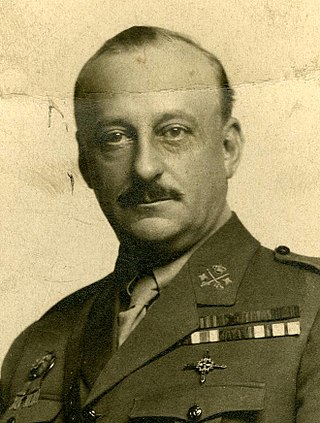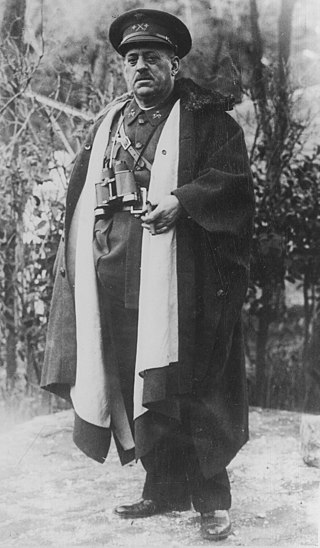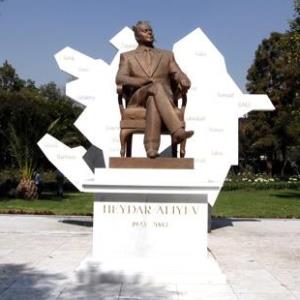
Francisco Franco Bahamonde was a Spanish military general who led the Nationalist forces in overthrowing the Second Spanish Republic during the Spanish Civil War and thereafter ruled over Spain from 1939 to 1975 as a dictator, assuming the title Caudillo. This period in Spanish history, from the Nationalist victory to Franco's death, is commonly known as Francoist Spain or as the Francoist dictatorship.

Melilla is an autonomous city of Spain on the North African coast. It lies on the eastern side of the Cape Three Forks, bordering Morocco and facing the Mediterranean Sea. It has an area of 12.3 km2 (4.7 sq mi). It was part of the Province of Málaga until 14 March 1995, when the Statute of Autonomy of Melilla was passed.

The Valley of Cuelgamuros, commonly known as the Valley of the Fallen, is a monument in the Sierra de Guadarrama, near Madrid. The valley contains a Catholic basilica and a monumental memorial in the municipality of San Lorenzo de El Escorial. Dictator Francisco Franco ordered the construction of the monumental site in 1940; it was built from 1940 to 1958, and opened in 1959. Franco said that the monument was intended as a "national act of atonement" and reconciliation.

Miguel Primo de Rivera y Orbaneja, 2nd Marquis of Estella, GE, was a Spanish dictator and military officer who ruled as prime minister of Spain from 1923 to 1930 during the last years of the Bourbon Restoration.

José Sanjurjo y Sacanell was a Spanish general who was one of the military leaders who plotted the July 1936 coup d'état that started the Spanish Civil War.

The Fuerzas Regulares Indígenas, known simply as the Regulares (Regulars), are infantry units of the Spanish Army, largely recruited in the cities of Ceuta and Melilla. Historically, the force, which has also included mounted divisions, has consisted of Berbers officered by Spaniards. The troops served as the indigenous component of the Army of Africa and played a significant role in the Spanish Civil War (1936-1939).

The Second Melillan campaign was a conflict in 1909 in northern Morocco around Melilla. The fighting involved local Riffians and the Spanish Army.

Law 52/2007, commonly known as Historical Memory Law, recognises and broadens "the rights and establishes measures in favour of those who suffered persecution or violence during the civil war and the dictatorship." It was passed by the Congress of Deputies on 31 October 2007, on the basis of a bill proposed by the PSOE government of Prime Minister José Luis Rodríguez Zapatero. The Historical Memory Law principally recognizes the victims on both sides of the Spanish Civil War, gives rights to the victims and the descendants of victims of the Civil War and of the subsequent dictatorship, and formally condemns the repressions of the Franco regime.

Manuel Goded Llopis was a Spanish Army general who was one of the key figures in the July 1936 revolt against the democratic government of Manuel Azanã. Having unsuccessfully led an attempted insurrection in Barcelona, he was captured and executed by the Republican government. Previously, Goded had distinguished himself in the Battle of Alhucemas of the Rif War.

The symbols of Francoism were iconic references to identify the Francoist State in Spain between 1936 and 1975. They serve as visual illustrations for the ideology of Francoist Spain. Uniforms were designed for men and women that combined elements of the earlier Falangist and Carlist uniforms. The state developed new flags and escutcheons based on the traditional heraldry of the monarchy, but now associated with the state. The emblem of five arrows joined by a yoke was also adopted from earlier Spanish symbology, but after 1945 the arrows always pointed upward. This emblem appeared on buildings, plaques and uniforms.

The Alhucemas landing was a landing operation which took place on 8 September 1925 at Alhucemas by the Spanish Army and Navy and, in lesser numbers, an allied French naval and aerial contingent, that would put an end to the Rif War. It is considered the first amphibious landing in history involving the use of tanks and massive seaborne air support. Alhucemas is seen as a precursor of the Allied amphibious landings in World War II, and the first successful combined operation of the 20th century.

The statue of Heydar Aliyev is a bronze sculpture of the third president of Azerbaijan, Heydar Aliyev, previously installed along Paseo de la Reforma, in Chapultepec, Miguel Hidalgo, Mexico City.

The 2023 Melilla Assembly election was held on Sunday, 28 May 2023, to elect the 8th Assembly of the autonomous city of Melilla. All 25 seats in the Assembly were up for election. The election was held simultaneously with regional elections in twelve autonomous communities and local elections all throughout Spain.

Indalecio Prieto Tuero or, simply, the Statue of Indalecio Prieto, is an instance of public art located in Madrid, Spain. Located next the Nuevos Ministerios building complex, it consists of a bronze statue depicting Indalecio Prieto, minister of Public Works during the Second Spanish Republic and promoter of the construction of the Nuevos Ministerios.

The equestrian statue of Francisco Franco was an instance of public art in Madrid, Spain. The statue, depicting dictator Francisco Franco riding a horse, was removed from its location in Nuevos Ministerios and subsequently stored in March 2005.

The Statue of Almanzor is a 2002 statue depicting the medieval Islamic Spanish ruler Almanzor. It originally sat in what are now believed to be Christian ruins in the southern Spanish city of Algeciras. It was removed in 2013 and has yet to be reinstalled.
A bronze bust of Abd al-Rahman III, the first Caliph of Córdoba, was unveiled in June 2016 in the small Spanish town of Cadrete near Zaragoza in Aragon. Three years later, it was removed by the right-wing new local government. The removal prompted debate on how Spain should interpret the legacy of Al-Andalus, the Muslim realms of the Middle Ages.

The Monumento Encuentro refers to two bronze statues seated on a bench in Colonia Tabacalera, Cuauhtémoc, Mexico City, designed by Óscar Ponzanelli in 2017. Otherwise known as the bench of Fidel Castro and Che Guevara and the statues of Fidel Castro and Che Guevara, the artwork features sitting statues of Fidel Castro and Che Guevara, major figures of the Cuban Revolution (1953–1959). The monument references the first time both met in 1955 in Tabacalera.
Gloria Rojas Ruiz is a Spanish Socialist Workers' Party (PSOE) politician. She has served as her party's leader in the Assembly of Melilla since 2015 and as its secretary-general in Melilla since 2017.

New Melilla or Ensanche de Melilla is the widening of the Spanish city of Melilla that emerged in the 19th century, but especially during the 20th century.


















